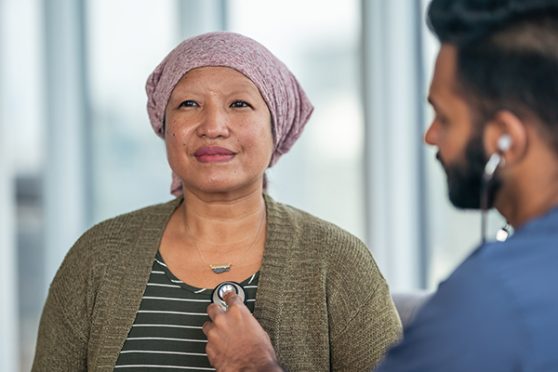Lung cancer survivorship really begins at the time of diagnosis, with patients searching for ways to live longer with the disease as soon as they hear their doctor utter the words.
“Given the aggressive nature of this cancer, the ideal scenario would be to prevent it from ever even occurring. Unfortunately, most cases of lung cancer are asymptomatic, with no signs the disease has started until it presents at an advanced stage and already spread to lymph nodes or other organs,” said Jennifer Worth, MD, MBA, FACS, medical director of thoracic surgery with the Hartford HealthCare Cancer Institute in eastern Connecticut.
Lung cancer is the most common cause of cancer death in the U.S., causing more deaths than colon, breast and prostate cancers combined. The American Cancer Society estimates there will be 236,740 new cases of lung cancer diagnosed in 2022, 117,910 in men and 118,830 in women.
Many will be diagnosed through lung cancer screening programs developed to help identify the disease at early stages. This screening uses a special CT scan formatted to minimize the amount of radiation used, and should be done annually for higher risk patients.
“It’s important to note that nodules or other findings are often identified on the scans but do not indicate cancer. Based on the results of your scan, you may be referred to a lung specialist, called a pulmonologist, or a thoracic surgeon to help determine the significance of the abnormal findings,” said Dr. Worth.
Current guidelines for lung cancer screening eligibility include patients who:
- Are aged 50 to 80.
- Have a smoking history of a pack a day for 20 years, currently smoke or quit in the last 15 years.
- Are interested in treatment if cancer is identified.
Although lung cancer typically has no symptoms, anyone who develops a new cough or pneumonia that won’t go away despite treatment, coughs up blood, experiences unexplained weight loss or has persistent pain in the chest or ribs should talk to their doctor immediately.
If the screening reveals a tumor, you may be sent for other diagnostic tests to determine the type and stage of the cancer and identify next steps.
“There is no one correct way to diagnose lung cancer. The choice used is based on the specific characteristics of each patient’s disease, which we can determine through biopsy,” Dr. Worth said.
Biopsy options include:
- Image-guided biopsy. This is usually an outpatient procedure to extract cells from the tumor with a needle. You may be sedated.
- Bronchoscopy. For this outpatient procedure, a scope is placed into the airway to biopsy the tumor. Hartford HealthCare uses the most cutting-edge robotic tools to diagnosis and understand all the aspects of the tumor. These procedures usually require general anesthesia.
- Mediastinoscopy. A scope is inserted into the chest through a small incision in the neck to get lymph node biopsies. This requires general anesthesia.
After diagnosis and staging, your cancer will be examined by a broad group of Cancer Institute specialists to determine the best personalized treatment plan. For early stage lung cancers, options focus on eradicating the tumor through surgical removal using the most modern minimally-invasive robotic approaches.
Radiation, including highly-focused stereotactic techniques, is considered for patients who are not eligible for surgery. When the cancer is more advanced or has spread to the lymph nodes, options can include chemotherapy, targeted molecular therapy or other immunotherapy treatments, sometimes combined with radiation therapy. Through our partnership with Memorial Sloan Kettering, Cancer Institute medical oncologists have access to the latest research studies and medications.
The good news is that lung cancer mortality has dropped up to 40 percent in the last 10 years, Dr. Worth said, resulting from decreased tobacco use and substantial improvements in therapy.
“This exciting trend means many more people survive the disease and live their lives,” she said.
The Cancer Institute team of nurse navigators, social workers, nutritionists, physical therapists and other support specialists can help patients deal with the long-term effects of cancer therapy and strive towards as much normalcy as possible.
“The diagnosis of any cancer, especially lung cancer, is particularly scary. We partner with patients to ensure that all their needs are met, the cancer is well cared for, and they continue to thrive and survive despite this difficult diagnosis,” Dr. Worth said.



